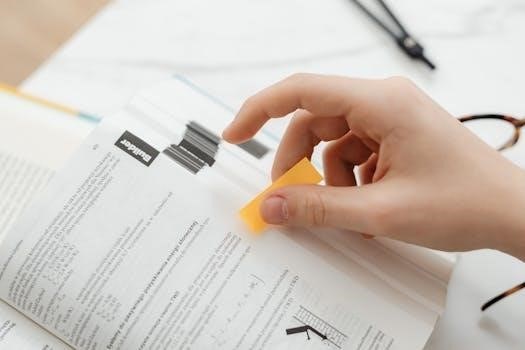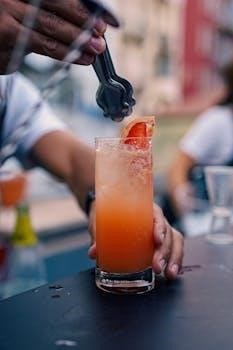bartender training manual
Bartender Training Manual⁚ A Comprehensive Guide
This comprehensive guide provides essential resources and tools for aspiring and current bartenders. It encompasses basic skills, mixology, customer service, and legal aspects. Explore training programs, schools, and techniques to excel in the dynamic bartending industry, ensuring competence and career advancement.
Bartending is a multifaceted profession blending artistry, customer service, and in-depth knowledge of alcoholic and non-alcoholic beverages. This manual serves as an introductory guide, designed to equip aspiring bartenders with the foundational skills and understanding necessary to succeed in this exciting and dynamic field. We’ll explore the history of bartending, tracing its evolution from simple taverns to sophisticated cocktail bars.
This section will cover the essential tools and equipment used behind the bar, from shakers and strainers to jiggers and muddlers. Understanding the purpose and proper use of each tool is crucial for efficient and precise drink preparation. Furthermore, we’ll delve into the different categories of alcoholic beverages, including spirits, wines, and beers, examining their unique characteristics and production methods.
Finally, this introduction will highlight the importance of professionalism, responsible alcohol service, and maintaining a clean and organized workspace. These elements are paramount to creating a positive customer experience and ensuring a safe and enjoyable environment for everyone.

Core Bartending Skills
Mastering core bartending skills is vital for success. This section covers essential techniques like pouring, mixing, and garnishing. It also emphasizes customer interaction, order accuracy, and maintaining a clean, efficient bar area, building a solid foundation.
Mixology Basics and Cocktail Recipes
Understanding mixology is fundamental for any bartender. This section introduces essential concepts, including the proper use of bar tools, accurate measurements, and layering techniques to craft balanced and visually appealing cocktails. Mastering these basics ensures consistency and quality in every drink.

Explore a curated collection of classic and contemporary cocktail recipes. Each recipe includes a detailed ingredient list, step-by-step instructions, and garnishing suggestions. Learn to prepare popular drinks like the Old Fashioned, Margarita, and Mojito, as well as innovative creations that showcase your mixology skills.
This section also covers the art of creating your own signature cocktails. Learn how to balance flavors, experiment with different ingredients, and develop unique recipes that reflect your personal style. By mastering mixology basics and exploring diverse cocktail recipes, you’ll be well-equipped to impress customers and elevate the bar experience.
Customer Service Excellence
Exceptional customer service is vital for success in bartending. Creating a welcoming and positive atmosphere enhances the customer experience and fosters loyalty. This section provides strategies for engaging with patrons, anticipating their needs, and resolving issues effectively.
Learn techniques for active listening, clear communication, and personalized service. Understand how to read body language, remember orders, and offer recommendations that align with customer preferences. By mastering these skills, you’ll build rapport and create memorable experiences.
This section also covers handling difficult situations with grace and professionalism. Learn how to address complaints, manage intoxicated customers, and maintain composure under pressure. Developing these skills ensures a safe and enjoyable environment for everyone. Ultimately, customer service excellence transforms a simple drink into a valued and returning customer.

Advanced Bartending Techniques
Elevate your bartending skills beyond the basics. This section explores advanced techniques, including crafting complex cocktails, mastering speed and efficiency, and understanding flavor profiles. Learn to create unique drinks and provide exceptional service, setting yourself apart in the industry.
Flair Bartending and Showmanship
Flair bartending is the art of entertaining guests with visually impressive displays while preparing drinks. It combines mixology with juggling, bottle spinning, and other acrobatic feats. While optional, mastering flair can significantly enhance the customer experience and boost tips.
This section covers basic and advanced flair techniques, emphasizing safety and precision. Learn the proper grip for bottles and shakers, mastering simple spins and tosses before progressing to more complex routines. Practice consistently to develop muscle memory and confidence.
Showmanship is equally important. Engage with customers, maintain eye contact, and smile. Tell stories, make jokes, and create a memorable experience. Understand your audience and tailor your performance accordingly.
Remember, flair should complement, not overshadow, the quality of the drinks. Prioritize accuracy and speed while adding flair elements to create a captivating performance. Ethical considerations include avoiding over-pouring and promoting responsible drinking.
By combining technical skills with engaging showmanship, you can become a sought-after bartender who entertains and delights customers, ultimately enhancing their overall bar experience.
Liquor Cost Management and Inventory Control
Effective liquor cost management and inventory control are crucial for bar profitability. This section outlines strategies to minimize waste, prevent theft, and maximize revenue. Understanding these principles ensures sustainable bar operations and financial success.
Inventory control begins with accurate tracking. Implement a system to record all incoming and outgoing liquor, noting quantities, dates, and costs. Regular inventory audits, at least weekly, identify discrepancies and potential issues promptly. Use technology, such as bar inventory software, to streamline the process.
Cost management involves optimizing purchasing practices. Negotiate with suppliers for competitive pricing and bulk discounts. Monitor pour costs closely, ensuring accurate measurements using jiggers and pour spouts. Train staff on proper pouring techniques to minimize over-pouring.
Waste reduction strategies include minimizing spills, properly storing liquor to prevent spoilage, and utilizing older stock before newer deliveries. Implement a system for tracking and disposing of expired or damaged products.
Security measures are essential to prevent theft. Secure liquor storage areas and monitor access. Implement surveillance systems and conduct regular staff training on loss prevention. By implementing these practices, you can maintain a profitable and well-managed bar.

Legal and Safety Aspects
This section covers alcohol awareness, responsible beverage service, bar hygiene, and safety standards. Adherence to these guidelines ensures a safe environment for staff and patrons while minimizing legal liabilities and promoting responsible alcohol consumption within the establishment.
Alcohol Awareness and Responsible Beverage Service
Bartenders must prioritize responsible alcohol service, understanding legal drinking age verification processes and recognizing signs of intoxication. Comprehensive training programs emphasize techniques for refusing service to visibly intoxicated patrons, preventing over-service, and intervening in potential alcohol-related incidents.
Bartenders should be familiar with local regulations regarding alcohol sales, including hours of operation, permissible drinks, and restrictions on promotions. Ongoing education about the effects of alcohol on the body and responsible drinking practices is essential for promoting patron safety and minimizing risks associated with alcohol consumption.
Effective communication strategies for addressing intoxicated individuals and offering alternative transportation options are crucial skills. Furthermore, bartenders should be trained to handle situations involving minors attempting to purchase alcohol, understanding the severe consequences of such violations. Responsible beverage service protects patrons, the establishment, and the bartender’s career, fostering a safe and enjoyable environment.
Bartenders must also be aware of dram shop laws and their potential liability in cases of alcohol-related harm caused by over-served patrons.
Bar Hygiene and Safety Standards
Maintaining impeccable bar hygiene is paramount for preventing contamination and ensuring customer well-being. This involves rigorous cleaning schedules for all surfaces, glassware, and equipment, adhering to strict sanitation protocols. Proper handwashing techniques are essential, along with the use of clean bar towels and utensils.
Food safety practices must be diligently followed when handling garnishes and preparing mixed drinks, minimizing the risk of foodborne illnesses. Glassware should be thoroughly washed and sanitized after each use, and ice machines must be regularly cleaned to prevent mold and bacteria growth.
Safety standards encompass hazard identification and prevention, including proper handling of sharp objects, spill management, and awareness of potential fire hazards. Emergency procedures, such as evacuation plans and first aid protocols, should be clearly defined and regularly practiced. Bartenders must be trained to recognize and address potential risks, creating a secure environment for both staff and patrons.
Adherence to these hygiene and safety standards demonstrates professionalism, builds customer trust, and protects the establishment’s reputation. Regular inspections and training sessions reinforce best practices, ensuring a consistently safe and sanitary bar environment.
